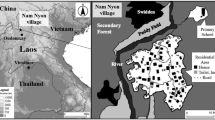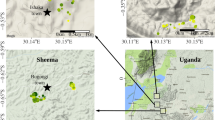Abstract
Should pastoralists in dryland Africa diversify or specialize in their productive activities? To investigate this question, we analyze data from a consumption survey and two surveys of the nutritional status of children in addition to qualitative interviews comparing nomadic and sedentary population groups in the Gourma area in northern Mali. We show how the children of pastoralists seem to be better nourished than children of sedentary farmers and that the children of the sedentarized nomads seem to be the worst off. Based on these findings, we first argue that sedentary farming appears to be a poorer adaptation than nomadic pastoralism in arid environments such as the northern Sahel. Secondly, we argue that the diversification argument (better to stand on two legs than one) is flawed for mobile pastoralists in the northern Sahel because the logistical and organizational costs of combining different modes of livelihood are large and easily become insurmountable for a single household.







Similar content being viewed by others
Notes
Nomads are here defined as mobile pastoralists who support their livelihoods mainly through livestock management. We use the terms “nomads,” “pastoralists” and “herders” interchangeably in this paper.
The Tuareg call themselves Kel Tamasheq, meaning “the people who speak tamasheq.” While the imushar, ineslemen and imghad are mainly of a Berber origin, the inhaden and Bella descend from black Africans. Sometimes, the term Tuareg is used only for the three former groups, while the term Kel Tamasheq would be used to include all five social layers (by e.g. Randall 2005). However, “Tuareg” is also commonly used, as we do, to denominate the whole Kel Tamasheq society.
While the other groups (imushar, ineslemen etc) are labeled as such by the population in the Gourma, there is no corresponding term for the “low status free.” The groups are only identified by the name of the group, such as Iborgheliten.
After the period discussed here, there have been even more changes, because of the rebellion in northern Mali during 1990–1996. The effects of the rebellion on the stratification and the division of labor are beyond the scope of this paper.
References
Ag Mahmoud, M. (1992). Le Haut Gourma Central, CEFE/CNRS, Montpellier.
Ag Sidiyene, E., and Klute, G. (1989). La Chronologie Des Années 1913–14 à 1987–88 Chez les Touregs Kal-adar du Mali. Journal des africanistes 59(1–2): 203–227.
Anderson, D. M. (1989). Agriculture and Irrigation Technology at Lake Baringo in the Nineteenth Century. Azania 24: 84–97.
Aune, J. (1991). Régénération Des Plaines à Panicum Laetum Dans le Gourma Malien. Revue Elev. Vét. Pays Trop. 44: 363–372.
Barth, F. (1967). Economic spheres in Darfur. In Firth, R. (ed.), Themes in economic anthropology. (ASA monograph, no. 6). Tavistock, London, pp. 149–174.
Bates, D. G., and Lees, S. H. (1977). The Role of Exchange in Productive Specialization. American Anthropologist 79: 824–840.
Benjaminsen, T. A. (1993). Fuelwood and Desertification: Sahel Orthodoxies Discussed on the Basis of Field Data from the Gourma Region in Mali. Geoforum 24(4): 397–409.
Benjaminsen, T. A. (1997). Natural Resource Management, Paradigm Shifts and the Decentralization Reform in Mali. Human Ecology 25(1): 121–143.
Benjaminsen, T. A. (2008). Does Supply-induced Scarcity Drive Violent Conflicts in the African Sahel? The Case of the Tuareg Rebellion in Northern Mali. Journal of Peace Research 45(6).
Benjaminsen, T. A., and Berge, G. (2004). Myths of Timbuktu: From African Eldorado to Desertification. International Journal of Political Economy 34(1): 31–59.
Benzécri, J. P. (1982) Histoire et préhistoire de l’analyse des données, Junod, Paris.
Berge, G. (2000). In Defence of Pastoralism. Form and Flux among Tuaregs in Northern Mali. PhD-dissertation, Department of Anthropology, University of Oslo.
Berge, G. (2001). Tuareg notions of space and place in Northern Mali. In Benjaminsen, T. A., and Lund, C. (eds.), Politics, Property and Production: Understanding Natural Resources Management in the West African Sahel, Nordic Africa Institute, Uppsala.
Berge, G., and Hveem, B. (1992). Marketed and Substitutable, But Not Integrated; the Sale of Local, Gathered Staples at the Gourma Rharous Market in Northern Mali. Paper presented at the 3. International Conference on Ethnobiology, Mexico City Nov. 1992.
Berger, P. G., and Ofek, E. (1995). Diversification’s Effect on Firm Value. Journal of Financial Economics 37: 39–66.
Bonfiglioli, A. M. (1988). Dudal: Histoire de Famille et Histoire de Troupeau Chez un Groupe de Wodaabe du Niger, Cambridge University Press, Cambridge.
Boserup, E. (1965/1993). The Conditions of Agricultural Growth, Earthscan, London.
Bourgeot, A. (1981). Pasture in the Malian Gourma: habitation by humans and animals. In Galagy, J., and Falznan, P. C. (eds.), The Future of Pastoral People, Proceedings from a conference held in Nairobi 4–8 August 1980, International Development Research Center, Ottawa, pp. 165–182.
Bryceson, D. F. (2002a). The Scramble in Africa: Reorienting Rural Livelihoods. World Development 30(5): 725–739.
Bryceson, D. F. (2002b). Multiplex Livelihoods in Rural Africa: Recasting the Terms and Conditions of Gainful Employment. Journal of Modern African Studies 40(1): 1–28.
Desta, S., and Coppock, D. L. (2004). Pastoralism Under Pressure: Tracking System Change in Southern Ethiopia. Human Ecology 32(4): 465–486.
Ellis, F. (2000). Rural Livelihoods and Diversity in Developing Countries, Oxford University Press, Oxford.
Fratkin, E., and Mearns, R. (2003). Sustainability and Pastoral Livelihoods: Lessons from East African Maasai and Mongolia. Human Organization 62(2): 112–122.
Fratkin, E., Roth, E. A., and Nathan, M. A. (2004). Pastoral Sedentarization and Its Effects on Children’s Diet, Health, and Growth among Rendille of Northern Kenya. Human Ecology 32(5): 531–559.
Fujita, M., Roth, E. A., Nathan, M. A., and Fratkin, E. (2004). Sedentism, Seasonality, and Economic Status: A Multivariate Analysis of Maternal Dietary and Health Statuses between Pastoral and Agricultural Ariaal and Rendille Communities in Northern Kenya. American Journal of Physical Anthropology 123: 277–291.
Gallais, J. (1975). Pasteurs et Paysans du Gourma, Centre National de Recherche Scientifique, Paris.
Gallais, J. (ed.) (1977). Stratégies Pastorals et Agricoles des Sahéliens Durant la Sécheresse 1969–1974. Centre d’Etudes de Géographie Tropicale, Domaine Universitaire de Bordeaux.
Greenacre, M. J. (1984). Theory and Applications of Correspondence Analysis, Academic Press, London.
Hampshire, K., and Randall, S. (2005). People are a resource. Demography & livelihoods in Sahelian FulBe of Burkina Faso. In Homewood, K. (ed.), Rural Resources & Local Livelihoods in Africa, James Currey, Oxford, pp. 123–136.
Hesse, C., and MacGregor, J. (2006). Pastoralism: Drylands Invisible Asset? Developing a Framework for Assessing the Value of Pastoralism in East Africa. IIED Issue Paper 142.
Isiugo-Abanihe, U. C. (1985). Child Fosterage in West Africa. Population and Development Review 11(1): 53–73.
Jul-Larsen, E. (1980). Fra demninger og feller til garn og liner: en analyse av teknologisk og sosial endring blant bozo-fiskere i Nigers sentraldelta,” DERAP publications 97, Chr. Michelsen Institute, Bergen.
Kerven, C. (1992). Customary Commerce—A Historical Reassessment of Pastoral Livestock Marketing in Africa, Overseas Development Institute, London.
Lamont, O. A., and Polk, C. (2001). The Diversification Discount: Cash Flows Versus Returns. Journal of Finance 56: 1693–1721.
Little, P. D., Smith, K., Cellarius, B. A., Coppock, D. L., and Barrett, C. B. (2001). Avoiding Disaster: Diversification and Risk Management among East African Herders. Development and Change 32: 401–433.
Marie, J. (1977). Stratégie traditionnelle d’adaptation à la sécheresse chez les éleveurs sahéliens. Perte en bétail, mobilité, ethnie. In Gallais, J. (ed.), Stratégies pastorals et agricoles des sahéliens durant la sécheresse 1969–1974, Centre d’Etudes de Géographie Tropicale, Domaine Universitaire de Bordeaux.
McCabe, J. T. (2003). Sustainability and Livelihood Diversification among the Maasai of Northern Tanzania. Human Organization 62(2): 100–111.
Niamir-Fuller, M. (ed.) (1999). Managing Mobility in African Rangelands. The Legitimization on Transhumance, FAO, Rome.
Nicolaisen, J. (1963). Ecology and Culture among the Pastoral Tuareg. National Museum, Copenhagen.
Oshaug, A., Pedersen, J., Diarra, M. M., Ag Bendech, M., and Hatløy, A. (1994). Problems and Pitfalls in the Use of Anthropometric Measurements: A Case from Mali. Journal of Nutrition 124: 636–644.
Pedersen, J. (1991). Les échantillonages statistiques dans le Gourma malien. Working paper. The Mali Programme, University of Oslo.
Pedersen, J. (1995). Drought, Migration and Population Growth in the Sahel—The Case of the Malian Gourma, 1960–1991. Population Studies 49(1): 111–126.
Randall, S. (2005). The Demographic Consequences of Conflict, Exile and Repatriation: A Case Study of Malian Tuareg. European Journal of Population 21: 291–320.
Randall, S., and Winter, M. (1985). The reluctant spouse and the illegitimate slave: marriage, household formation and demographic behaviour among Kel Tamasheq. In Hill, A. (ed.), Population, Health and Nutrition in the Sahel, Kegan Paul International, London.
Schneider, H. K. (1981). The Africans: An Ethnological Account. Prentice-Hall, Englewood Cliffs, NJ.
Scott, J. (1998). Seeing Like a State. How Certain Schemes to Improve the Human Condition Have Failed, Yale University Press, New Haven.
Silverman, B. W. (1986). Density Estimation for Statistics and Data Analysis, London, Chapman and Hall.
Snrech, S. (1995). Les transformations de l’agriculture ouest-africaine: Evolutions 1960–1990. Défis pour l’avenir. Implications pour les pays sahéliens. Club du Sahel, Paris.
Stenning, D. J. (1958). Household viability among the pastoral Fulani. In Goody, J. (ed.), The Developmental Cycle in Domestic Groups, Cambridge Papers in Social Anthropology, no. 1., Cambridge University Press, Cambridge.
Thébaud, B., and Batterbury, S. (2001). Sahel Pastoralists: Opportunism, Struggle, Conflict and Negotiation. A Case Study from Eastern Niger. Global Environmental Change 11: 69–78.
Acknowledgments
We are grateful to useful comments received from Ced Hesse and André Marty as well as from two anonymous referees. The research was part of the Mali Programme at the University of Oslo (1987–1996) where we were both based at the time of the main fieldwork for this study. The Programme was funded by the Norwegian Ministry of Foreign Affairs through its Sahel-Sudan-Ethiopia Programme.
Author information
Authors and Affiliations
Corresponding author
Rights and permissions
About this article
Cite this article
Pedersen, J., Benjaminsen, T.A. One Leg or Two? Food Security and Pastoralism in the Northern Sahel. Hum Ecol 36, 43–57 (2008). https://doi.org/10.1007/s10745-007-9136-3
Published:
Issue Date:
DOI: https://doi.org/10.1007/s10745-007-9136-3




